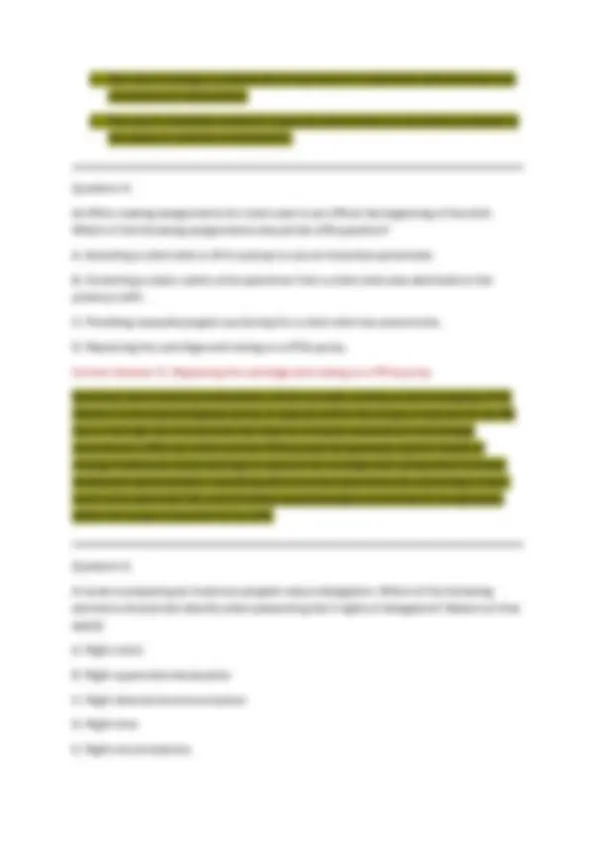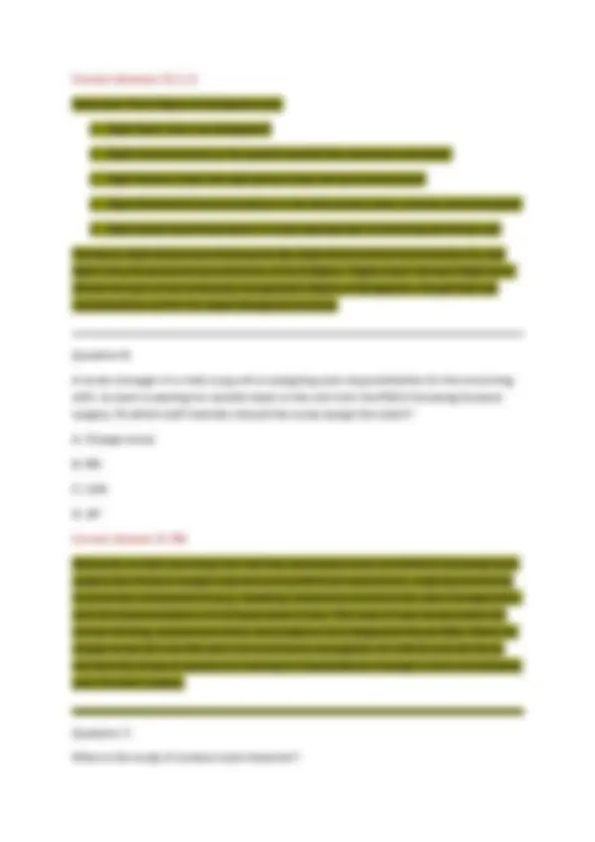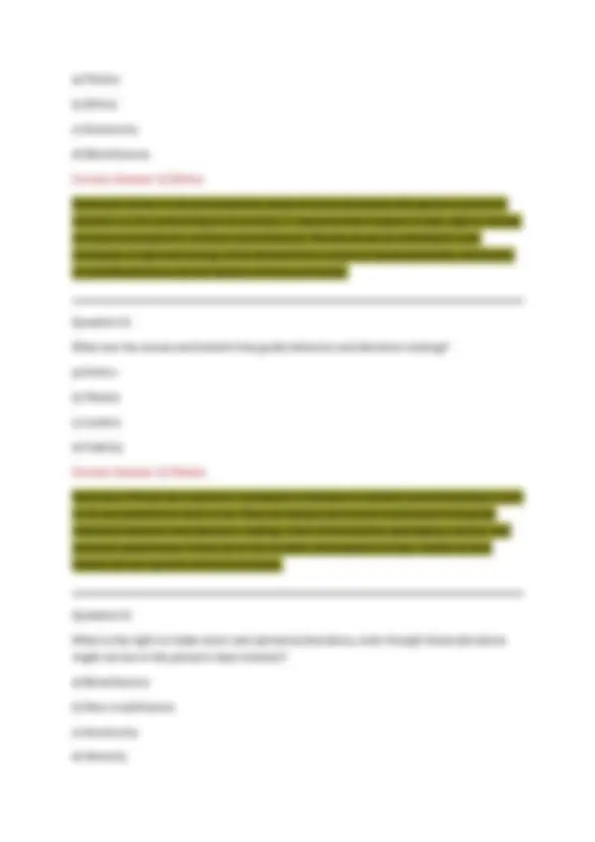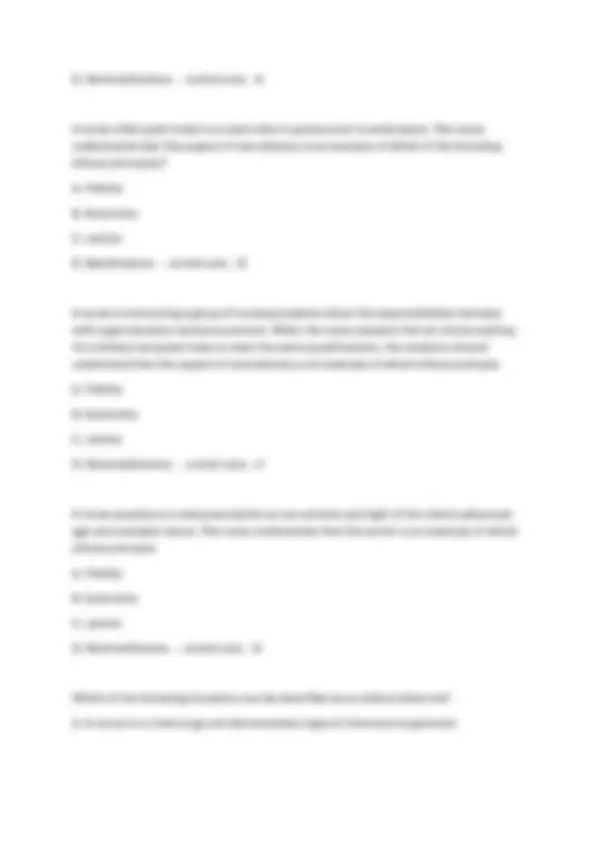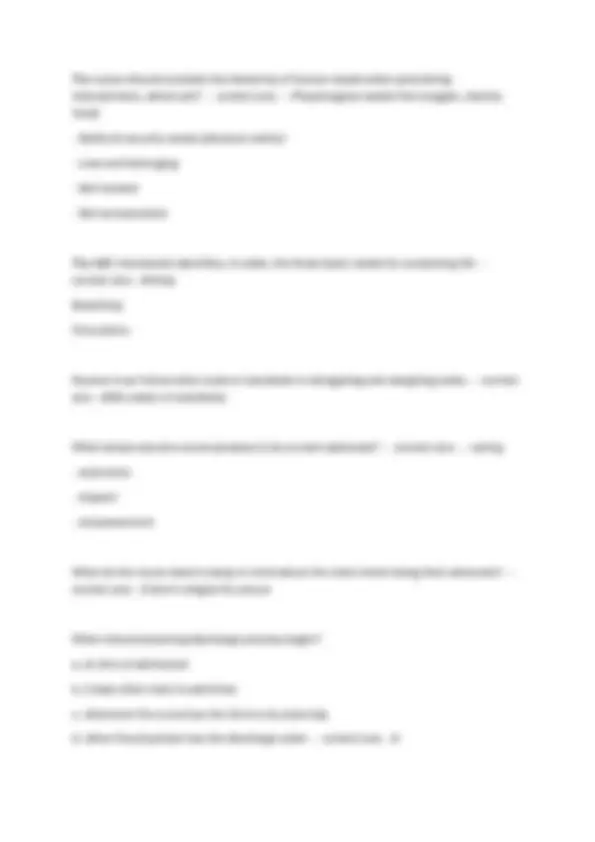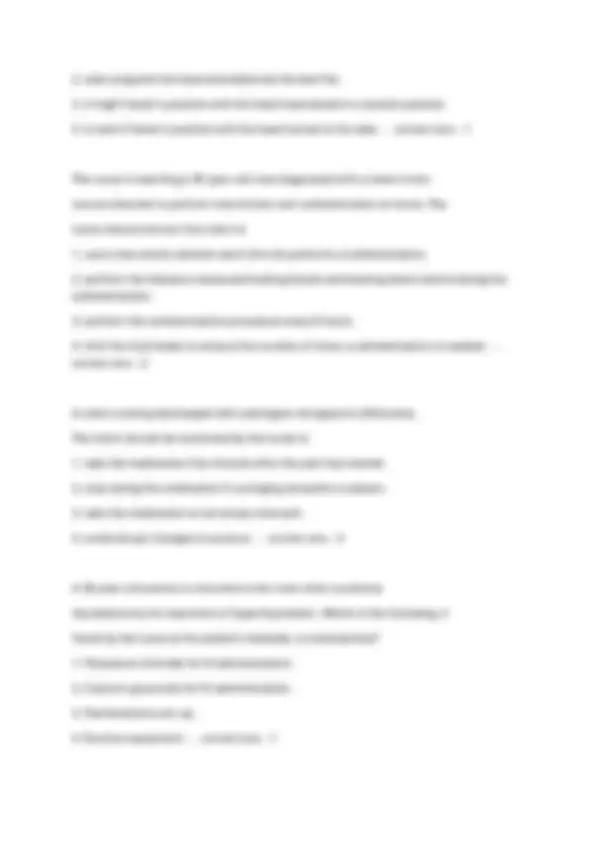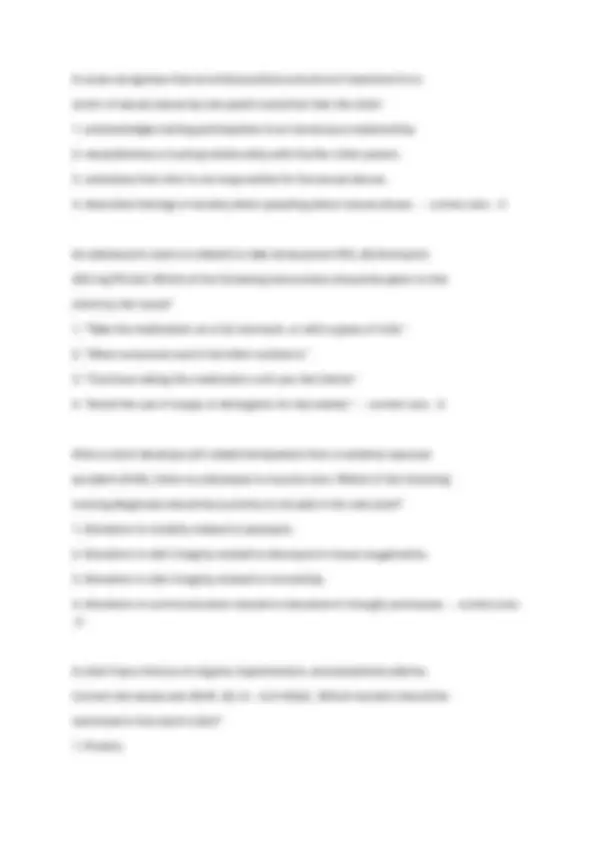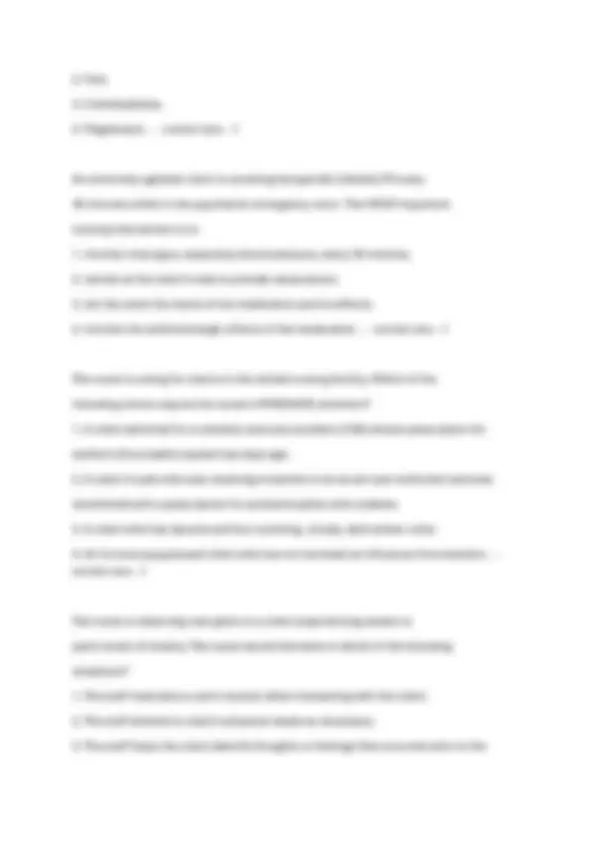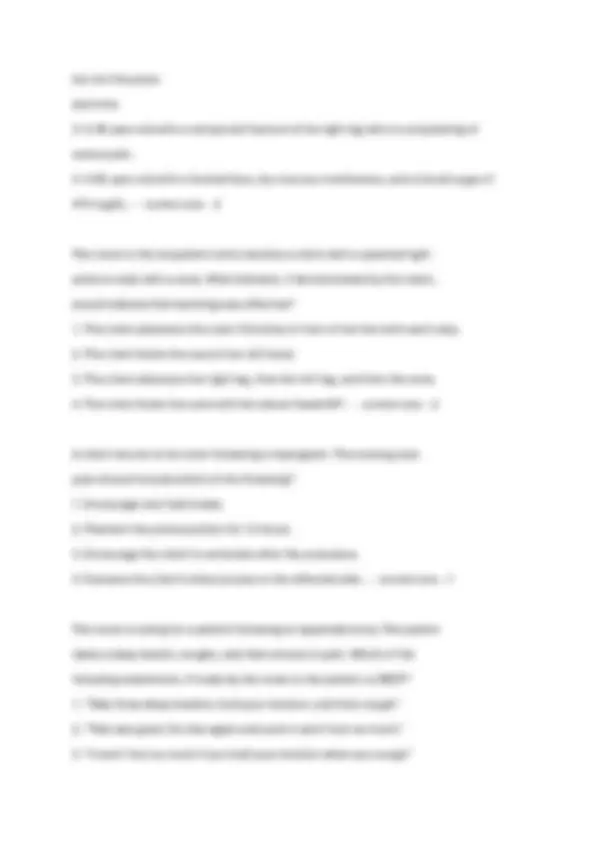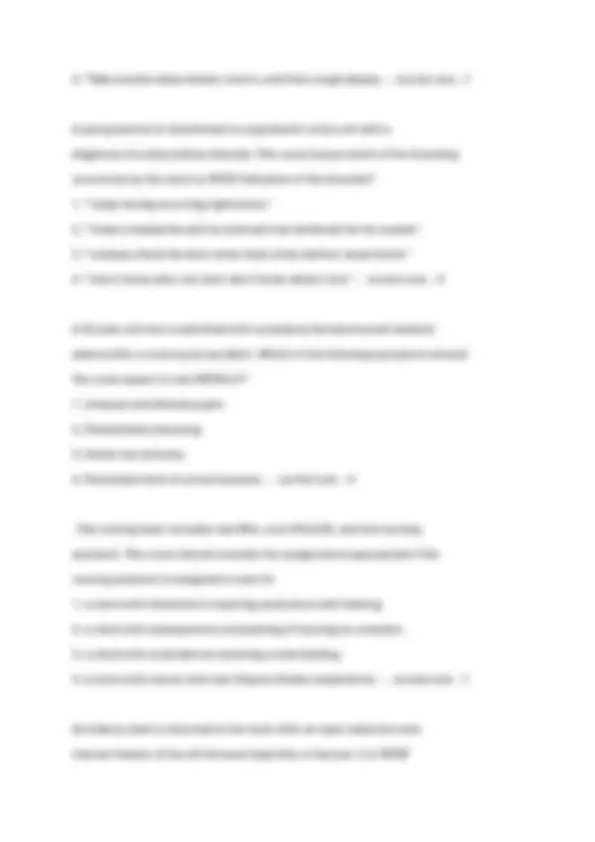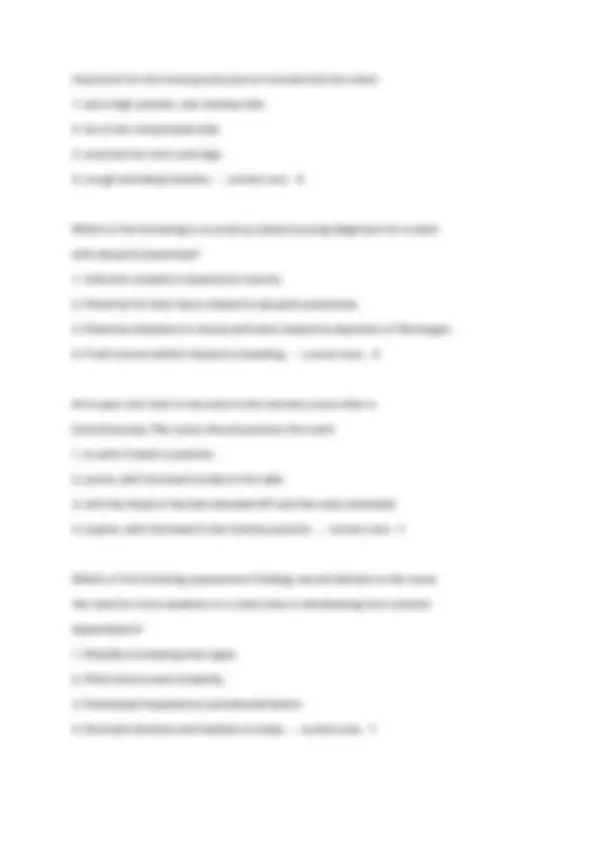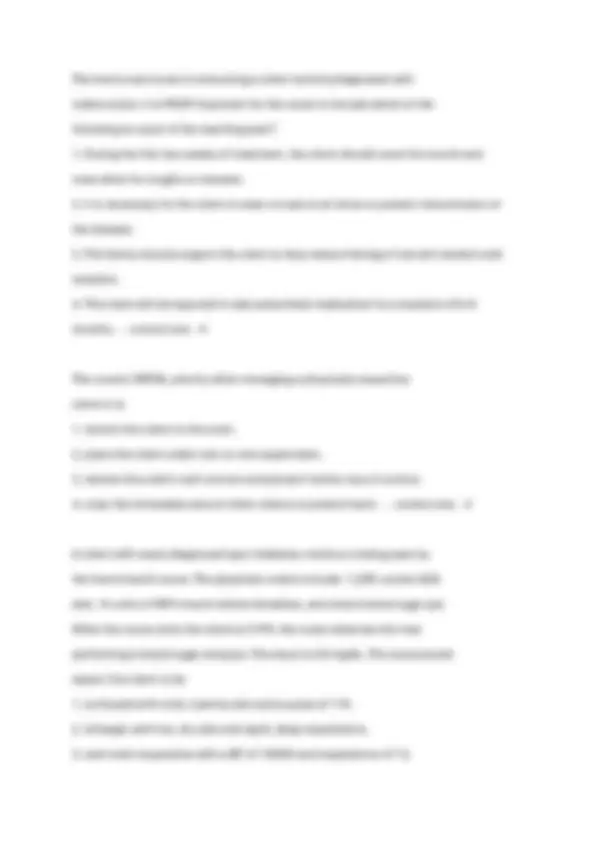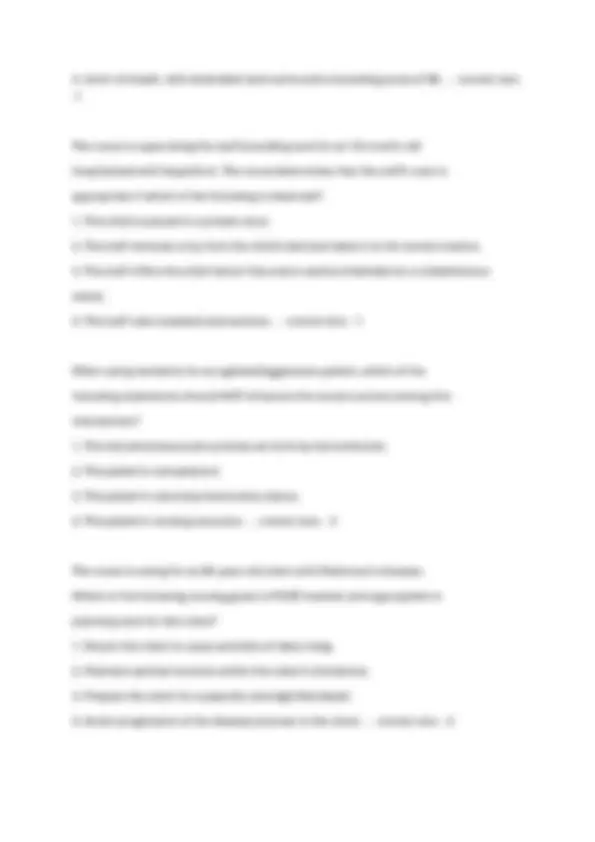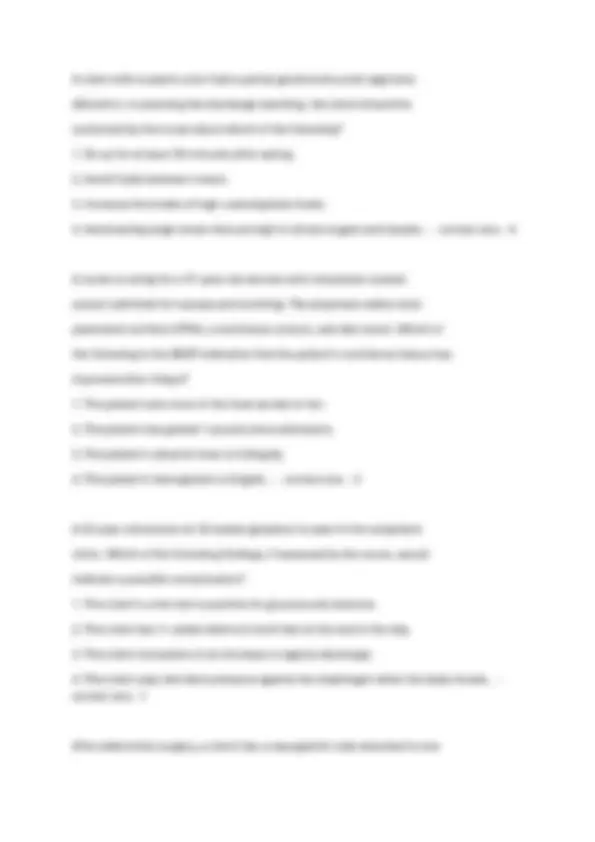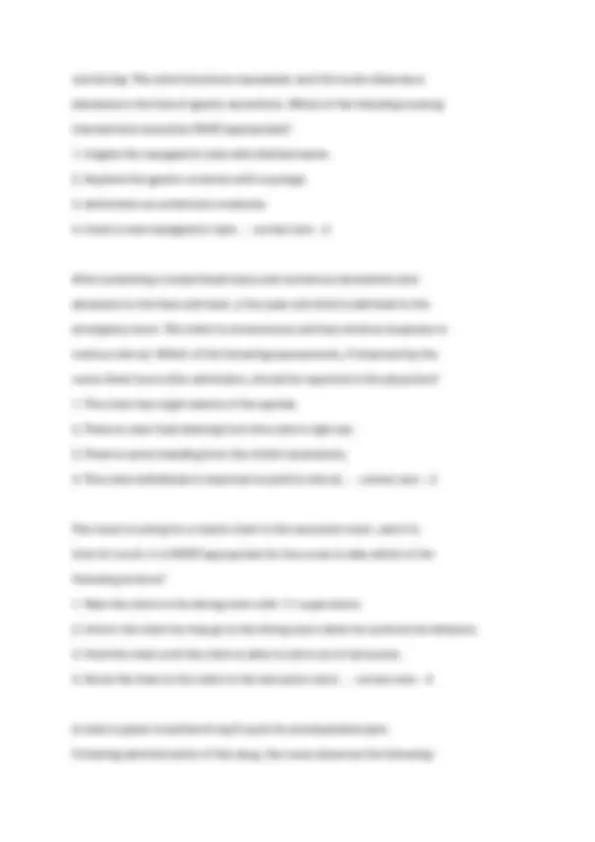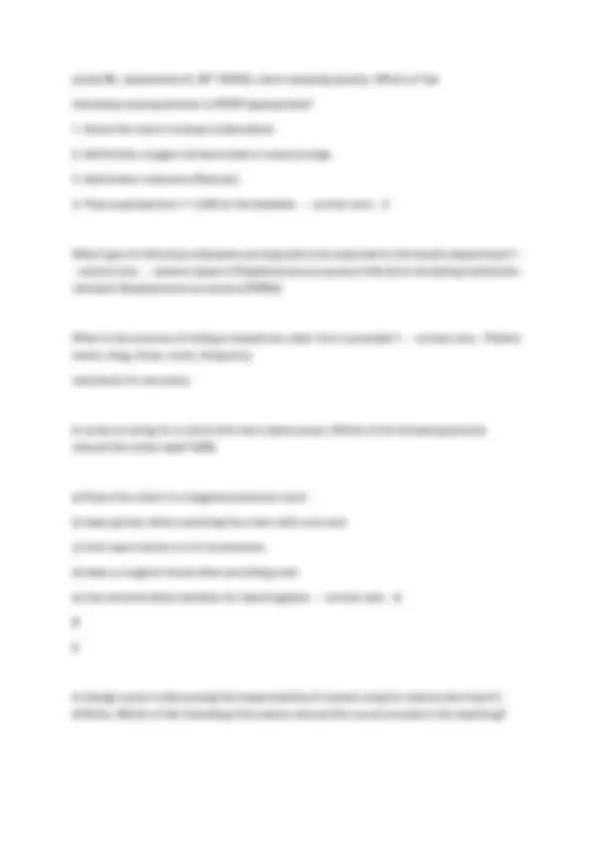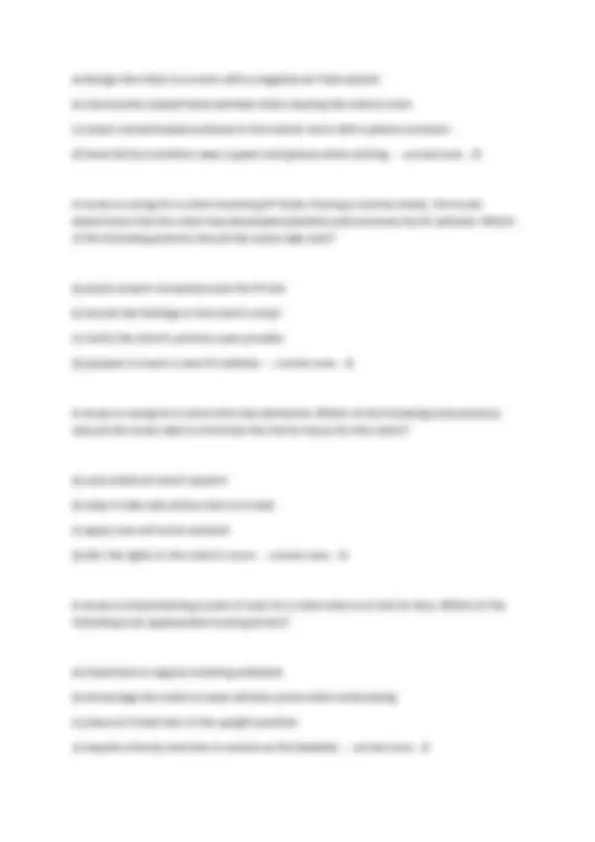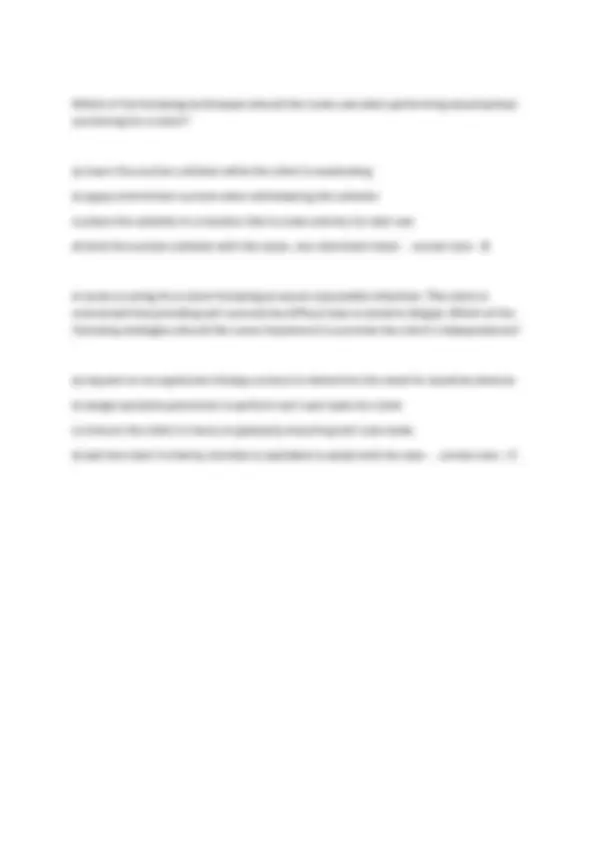Download A.T.I PN Comprehensive Predictor Exam 2025: Study Guide with Full Practice Tests, Expert and more Exams Nursing in PDF only on Docsity!
ATI PN Comprehensive Predictor Exam 2025:
Study Guide with Full Practice Tests, Expert-
Rated Answers, and Guaranteed Success Tips for
LPN/LVN Students
Here are multi-choice questions and rationales for each of the provided scenarios, with the correct answer indicated. Question 1: What can be delegated to Assistive Personnel (AP)? a) Administering oral medications to stable clients. b) Performing wound care for stage II pressure ulcers. c) Providing health education about a new diagnosis. d) Assisting with activities of daily living (ADLs) such as bathing and dressing. Correct Answer: d) Assisting with activities of daily living (ADLs) such as bathing and dressing. Rationale: Assistive Personnel (APs) are trained to perform basic patient care tasks, including ADLs, feeding (without swallow precautions), positioning, bed making, specimen collection (non-sterile), intake and output (I&O) measurement, and vital signs for stable clients. Administering medications (a), performing skilled wound care (b), and providing health education (c) require the knowledge and judgment of a licensed nurse and are outside the scope of practice for an AP. Question 2: A nurse on a med-surg unit has received a change of shift report and will care for 4 clients. Which of the following client needs will the nurse assign to an AP? A. Feeding a client who was admitted 24 hours ago with aspiration pneumonia. B. Reinforcing teaching with a client who is learning to walk with a quad cane.
C. Reapplying a condom catheter for a client who has urinary incontinence. D. Applying a sterile dressing to a pressure ulcer. Correct Answer: C. Reapplying a condom catheter for a client who has urinary incontinence. Rationale: Reapplying a condom catheter is a routine, non-sterile task that falls within the scope of practice for an AP. Feeding a client with aspiration pneumonia (A) requires assessment for swallow precautions, which is the nurse's responsibility. Reinforcing teaching (B) and applying a sterile dressing (D) require nursing knowledge, assessment, and judgment. Question 3: A nurse is delegating the ambulation of a client who had knee arthroplasty 5 days ago to an AP. Which of the following information should the nurse share with the AP? (Select all that apply) A. The roommate is up independently. B. The client ambulates with his slippers on over his antiembolic stockings. C. The client uses a front-wheeled walker when ambulating. D. The client had pain meds 30 minutes ago. E. The client is allergic to codeine. F. The client ate 50% of his breakfast this morning. Correct Answers: B, C, D Rationale: When delegating, the nurse must provide clear, concise, and specific instructions, including any relevant patient information or precautions.
- B. The client ambulates with his slippers on over his antiembolic stockings: This provides important information about the client's current status and specific equipment use during ambulation.
- C. The client uses a front-wheeled walker when ambulating: This informs the AP about the necessary assistive device for safe ambulation.
- D. The client had pain meds 30 minutes ago: This is crucial information as it indicates the client should have optimal pain control for ambulation and might be less resistant to movement, or conversely, might be slightly drowsy.
- A. The roommate's independence (A) is irrelevant to the client's ambulation task.
Correct Answers: B, C, E Rationale: The 5 Rights of Delegation are:
- Right Task: Can it be delegated?
- Right Circumstance: Is the patient stable? Are resources available?
- Right Person: Does the right person have the skills and scope?
- Right Direction/Communication: Is the instruction clear, concise, and complete?
- Right Supervision/Evaluation: Is there appropriate monitoring and follow-up? Therefore, Right Supervision/Evaluation (B), Right Direction/Communication (C), and Right Circumstances (E) are elements of the 5 Rights. "Right client" (A) and "Right time" (D) are not part of the universally recognized 5 Rights of Delegation, though they are considerations within the larger delegation process. Question 6: A nurse manager of a med-surg unit is assigning care responsibilities for the oncoming shift. A client is waiting for transfer back to the unit from the PACU following thoracic surgery. To which staff member should the nurse assign the client? A. Charge nurse B. RN C. LVN D. AP Correct Answer: B. RN Rationale: A client returning from the Post-Anesthesia Care Unit (PACU) following major surgery like thoracic surgery requires comprehensive assessment, ongoing monitoring for potential complications (e.g., bleeding, respiratory compromise, pain management), and the implementation of a complex plan of care. This level of care necessitates the critical thinking, assessment skills, and judgment of a Registered Nurse (RN). While the charge nurse (A) is an RN, their role is primarily managerial. An LVN (C) and AP (D) do not have the scope of practice or training to independently manage a client immediately post-thoracic surgery. Question 7: What is the study of conduct and character?
a) Morals b) Ethics c) Autonomy d) Beneficence Correct Answer: b) Ethics Rationale: Ethics is the philosophical study of moral principles that govern a person's behavior or the conducting of an activity. It^1 explores what is good or bad, right or wrong, and sets principles for conduct and character. Morals (a) are an individual's own principles of right and wrong, often derived from culture or personal beliefs. Autonomy (c) and Beneficence (d) are specific ethical principles. Question 8: What are the values and beliefs that guide behavior and decision making? a) Ethics b) Morals c) Justice d) Fidelity Correct Answer: b) Morals Rationale: Morals are a person's standards of behavior or beliefs concerning what is and is not acceptable for them to do. They are deeply held values and beliefs that guide individual behavior and decision-making, often influenced by upbringing, culture, and personal experiences. Ethics (a) is the broader philosophical study. Justice (c) and Fidelity (d) are specific ethical principles. Question 9: What is the right to make one's own personal decisions, even though those decisions might not be in the person's best interest? a) Beneficence b) Non-maleficence c) Autonomy d) Veracity
Question 12: What is fairness in care delivery and use of resources? a) Autonomy b) Beneficence c) Justice d) Non-maleficence Correct Answer: c) Justice Rationale: Justice, as an ethical principle, refers to fairness and equity in the distribution of resources and care. It implies treating all individuals equitably, regardless of their background or circumstances, and ensuring fair access to healthcare. Autonomy (a) is self-determination, Beneficence (b) is doing good, and Non-maleficence (d) is doing no harm. Question 13: What is avoidance of harm or injury? a) Beneficence b) Autonomy c) Non-maleficence d) Fidelity Correct Answer: c) Non-maleficence Rationale: Non-maleficence is a fundamental ethical principle that dictates "do no harm." It requires healthcare professionals to avoid causing harm or injury to their patients, both intentionally and unintentionally. Beneficence (a) is doing good, Autonomy (b) is self-determination, and Fidelity (d) is keeping promises. A nurse is caring for a client who decides not to have surgery despite significant blockages in his coronary arteries. The nurse understands that this clients choice is an example of what principles? A. Fidelity B. Autonomy C. Justice
D. Nonmalificience - - correct ans- - A A nurse offers pain meds to a client who is postop prior to ambulation. The nurse understands that this aspect of care delivery is an example of which of the following ethical principles? A. Fidelity B. Autonomy C. Justice D. Beneficience - - correct ans- - D A nurse is instructing a group of nursing students about the responsibilities involved with organ donation and procurement. When the nurse explains that all clients waiting for a kidney transplant have to meet the same qualifications, the students should understand that this aspect of care delivery is an example of which ethical principle A. Fidelity B. Autonomy C. Justice D. Nonmaleficence - - correct ans- - C A nurse questions a med prescription as too extreme and light of the clients advanced age and unstable status. The nurse understands that this action is an example of which ethical principle A. Fidelity B. Autonomy C. Justice D. Nonmalificence - - correct ans- - D Which of the following situations can be identified as an ethical dilemma? A. A nurse on a med surge unit demonstrates signs of chemical impairment
The nurse should consider the hierarchy of human needs when prioritizing interventions, which are? - - correct ans- -- Physiological needs first (oxygen, shelter, food)
- Safety & security needs (physical safety)
- Love and belonging
- Self esteem
- Self actualization The ABC framework identifies, in order, the three basic needs for sustaining life - - correct ans- - Airway Breathing Circulation Nurses must follow what code of standards in delegating and assigning tasks - - correct ans- - ANA codes of standards What values would a nurse possess to be a client advocate? - - correct ans- -- caring
- autonomy
- respect
- empowerment What do the nurse need to keep in mind about the client when being their advocate? - - correct ans- - Client's religion & culture When should planning discharge process begin? a. at time of admission b. 2 days after client is admitted c. whenever the nurse has the time to do planning d. when the physician has the discharge order - - correct ans- - A
What is an interdisciplinary team? - - correct ans- - A group of health care professionals from different disciplines Fill in the blank:
- _______ is used by interdisciplinary team to make health care decisions about clients with multiple problems. 2. ________, which may take place at team meetings, allows the achievement of results that the participants would be incapable of accomplishing if working alone. - - correct ans- - 1 & 2 = collaboration What is the nurse's contribution to an interdisciplinary team? - - correct ans- -- knowledge of nursing care & its management
- a holistic understanding of the client, her/his healthcare needs & healthcare systems. A four-month-old infant is admitted to the pediatric intensive care unit with a temperature of 105°F (40.5 °C). The infant is irritable, and the nurse observes nuchal rigidity. Which assessment finding would indicate an increase in intracranial pressure?
- Positive Babinski.
- High-pitched cry.
- Bulging posterior fontanelle.
- Pinpoint pupils. - - correct ans- - 2 A client is receiving total parenteral nutrition (TPN). To determine the client's tolerance of this treatment, the nurse should assess for which of the following?
- A significant increase in pulse rate.
- A decrease in diastolic blood pressure.
- Temperature in excess of 98.6°F (37°C).
- side-lying with his head extended and the bed flat.
- in high Fowler's position with his head maintained in a neutral position.
- in semi-Fowler's position with his head turned to the side. - - correct ans- - 1 The nurse is teaching a 40-year-old man diagnosed with a lower motor neuron disorder to perform intermittent self-catheterization at home. The nurse should instruct the client to
- use a new sterile catheter each time he performs a catheterization.
- perform the Valsalva maneuver(holding breath and bearing down) before doing the catheterization.
- perform the catheterization procedure every 8 hours.
- limit his fluid intake to reduce the number of times a catheterization is needed. - - correct ans- - 2 A client is being discharged with sublingual nitroglycerin (Nitrostat). The client should be cautioned by the nurse to
- take the medication five minutes after the pain has started.
- stop taking the medication if a stinging sensation is absent.
- take the medication on an empty stomach.
- avoid abrupt changes in posture. - - correct ans- - 4 A 38-year-old woman is returned to her room after a subtotal thyroidectomy for treatment of hyperthyroidism. Which of the following, if found by the nurse at the patient's bedside, is nonessential?
- Potassium chloride for IV administration.
- Calcium gluconate for IV administration.
- Tracheostomy set-up.
- Suction equipment. - - correct ans- - 1
A nurse recognizes that an initial positive outcome of treatment for a victim of sexual abuse by one parent would be that the client
- acknowledges willing participation in an incestuous relationship.
- reestablishes a trusting relationship with his/her other parent.
- verbalizes that s/he is not responsible for the sexual abuse.
- describes feelings of anxiety when speaking about sexual abuse. - - correct ans- - 3 An adolescent client is ordered to take tetracycline HCL (Achromycin) 250 mg PO bid. Which of the following instructions should be given to this client by the nurse?
- "Take the medication on a full stomach, or with a glass of milk."
- "Wear sunscreen and a hat when outdoors."
- "Continue taking the medication until you feel better."
- "Avoid the use of soaps or detergents for two weeks." - - correct ans- - 2 After a client develops left-sided hemiparesis from a cerebral vascular accident (CVA), there is a decrease in muscle tone. Which of the following nursing diagnoses would be a priority to include in his care plan?
- Alteration in mobility related to paralysis.
- Alteration in skin integrity related to decrease in tissue oxygenation.
- Alteration in skin integrity related to immobility.
- Alteration in communication related to decrease in thought processes - - correct ans-
- 2 A client has a history of oliguria, hypertension, and peripheral edema. Current lab values are: BUN - 25, K+ - 4.0 mEq/L. Which nutrient should be restricted in the client's diet?
- Protein.
onset of the anxiety.
- The staff assesses the client's need for medication or seclusion if other interventions have failed to reduce anxiety. - - correct ans- - 3 A 69-year-old client is undergoing his second exchange of intermittent peritoneal dialysis (IPD). Which of the following would require an intervention by the nurse?
- The client complains of pain during the inflow of the dialysate.
- The client complains of constipation.
- The dialysate outflow is cloudy.
- There is blood-tinged fluid around the intra-abdominal catheter. - - correct ans- - 3 The clinic nurse is performing diet teaching with a 67-year-old client with acute gout. The nurse should teach the client to limit his intake of
- red meat and shellfish.
- cottage cheese and ice cream.
- fruit juices and milk.
- fresh fruits and uncooked vegetables. - - correct ans- - 1 A client is scheduled for a left lower lobectomy. The physician has ordered diazepam (Valium) 2 mg IM for anxiety. The nurse would determine that the medication is appropriate if the client displays which of the following symptoms?
- Agitation and decreased level of consciousness.
- Lethargy and decreased respiratory rate.
- Restlessness and increased heart rate.
- Hostility and increased blood pressure. - - correct ans- - 3
A 59-year-old woman with bipolar disorder is receiving haloperidol (Haldol) 2 mg PO tid. She tells the nurse, "Milk is coming out of my breasts." Which of the following responses by the nurse is BEST?
- "You are seeing things that aren't real."
- "Why don't we go make some fudge."
- "You are experiencing a side effect of Haldol."
- "I'll contact your physician to change your medication." - - correct ans- - 3 The physician orders ranitidine hydrochloride (Zantac) 150 mg PO qd for a client. The nurse should advise the client the BEST time to take this medication is
- before breakfast.
- with dinner.
- with food.
- at hs. - - correct ans- - 4 . If a client develops cor pulmonale (right-sided heart failure), the nurse would expect to observe
- increasing respiratory difficulty seen with exertion.
- cough productive of a large amount of thick, yellow mucus.
- peripheral edema and anorexia.
- twitching of extremities. - - correct ans- - 3 The nurse is performing triage on a group of clients in the emergency department. Which of the following clients should the nurse see FIRST?
- A 12-year-old oozing blood from a laceration of the left thumb due to cut on a rusty metal can.
- A 19-year-old with a fever of 103.8°F (39.8°C) who is able to identify her sister
- "Take another deep breath, hold it, and then cough deeply - - correct ans- - 1 A young woman is transferred to a psychiatric crisis unit with a diagnosis of a dissociative disorder. The nurse knows which of the following comments by the client is MOST indicative of this disorder?
- "I keep having recurring nightmares."
- "I have a headache and my stomach has bothered me for a week."
- "I always check the door locks three times before I leave home."
- "I don't know who I am and I don't know where I live." - - correct ans- - 4 A 23-year-old man is admitted with a subdural hematoma and cerebral edema after a motorcycle accident. Which of the following symptoms should the nurse expect to see INITIALLY?
- Unequal and dilated pupils.
- Decerebrate posturing.
- Grand mal seizures.
- Decreased level of consciousness. - - correct ans- - 4 . The nursing team includes two RNs, one LPN/LVN, and one nursing assistant. The nurse should consider the assignments appropriate if the nursing assistant is assigned to care for
- a client with Alzheimer's requiring assistance with feeding.
- a client with osteoporosis complaining of burning on urination.
- a client with scleroderma receiving a tube feeding.
- a client with cancer who has Cheyne-Stokes respirations. - - correct ans- - 1 An elderly client is returned to her room after an open reduction and internal fixation of the left femoral head after a fracture. It is MOST
important for the nursing care plan to include that the client
- eat a high-protein, low-residue diet.
- lie on her unoperated side.
- exercise her arms and legs.
- cough and deep breathe. - - correct ans- - 4 Which of the following is a correctly stated nursing diagnosis for a client with abruptio placentae?
- Infection related to obstetrical trauma.
- Potential for fetal injury related to abruptio placentae.
- Potential alteration in tissue perfusion related to depletion of fibrinogen.
- Fluid volume deficit related to bleeding. - - correct ans- - 4 An 8-year-old client is returned to the recovery room after a bronchoscopy. The nurse should position the client
- in semi-Fowler's position.
- prone, with the head turned to the side.
- with the head of the bed elevated 45° and the neck extended.
- supine, with the head in the midline position. - - correct ans- - 1 Which of the following assessment findings would indicate to the nurse the need for more sedation in a client who is withdrawing from alcohol dependence?
- Steadily increasing vital signs.
- Mild tremors and irritability.
- Decreased respirations and disorientation.
- Stomach distress and inability to sleep. - - correct ans- - 1

